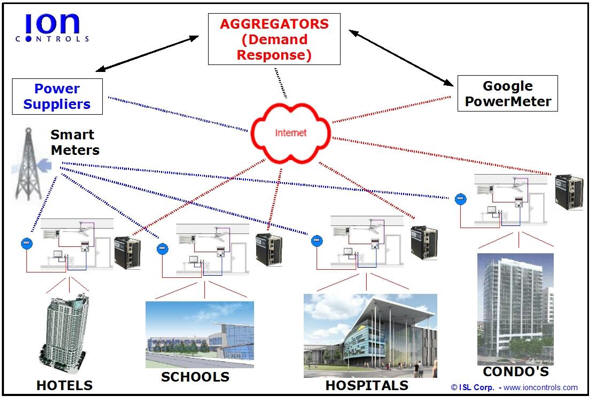September 2009
![]()
AutomatedBuildings.com
[an error occurred while processing this directive]
(Click Message to Learn More)
September 2009 |
[an error occurred while processing this directive] |
|
|
Mark Hunter |
"If you cannot measure it, you cannot improve it." - Lord Kelvin.
|
|
|
|
|
|
|
|
|
|
|
|
|
[an error occurred while processing this directive] |
|
|
|
|
|
|
|
|
|
|
|
|
|
|
|
[an error occurred while processing this directive] |
I've just returned from a summer holiday break in Vietnam which is a country in a hurry to throw off its communist system and move to an open free market, capitalistic economy. As such, it is going through difficult growing pains, one of which is the need for more energy to power this growth.
The hotel rooms I stayed in all had split aircon units and with temperatures above 86 Deg. F they are needed and big time. In an honorable attempt to save energy, the hotel room key system was linked to the power supply for the room - no key in the slot - no power. Unfortunately, this also killed the mini bar fridge which contains that other necessity for life in 86 Deg. F climes - colder beverages. Naturally, it was pretty easy to overcome the key slot power supply 'occupancy detector' proxy to ensure cold beverages on return from hot beach (I made sure the aircon was off).
This critical need to save energy in Vietnam was pretty apparent by a couple of minor brown outs that occurred. Which brings us back to my compatriot, Lord Kelvin's quote and the need to accurately measure what you are using, in this case, electricity. I'm pretty sure the hotels mentioned are aware that their electricity is being used excessively but not how or where and hence no systematic way to improve this usage. (A simple but effective way to save energy in this hotel room scenario to be revealed later.)
This then brings us neatly on to our subject matter - so called 'smart' meters.
All around the world governments are promoting and legislating for the installation of smart meters at all points of end usage. The main goal being that energy savings should result. For instance, a number of studies have shown that if home owners are aware of their real time power consumption, they actively alter their usage behavior to reduce consumption leading to approx. 10% savings.
So in countries such as the UK, there are government backed, ie tax payer funded schemes to provide in each home, portable power display units linked to the newly installed electrical 'smart' meters - also paid for by the tax payer. But will people really continue to alter their behavior for the sake of saving 10% of their energy consumption once the novelty of real time measuring wears off? I doubt it. Perhaps for the die hard greenies and tree huggers that constitute probably less than 15% of all house owners.
Ah, but you say, the other side of the smart meter is that it has this Home Automation (HA) interface that enables electrical equipment to be switched off during times of high peak tariffs. In the UK this interface has not even been specified and in New Zealand* hundreds of thousands of so called 'smart' meters have been fitted with no interface or even real time display.
*http://www.nzherald.co.nz/electricity/news/article.cfm?c_id=187&objectid=10580773
In the USA, the specification is much better with the standards calling for amongst other things an open protocol Zigbee wireless interface. However, I again have my doubts on whether all the hype surrounding zigbee will pan out. Zigbee has been around for years in the building controls industry and has had a minimal uptake and only in niche applications. I just can't see home owners forking out for more expensive ZigBee enabled fridges, washing machines and dryers and more importantly, the complexity of installing, programming and managing such a network for a minimal energy saving return.
 And if
you are going to specify a wireless communication protocol why not use a
standard that is already in millions of homes and devices and people use
everyday, ie WiFi.
And if
you are going to specify a wireless communication protocol why not use a
standard that is already in millions of homes and devices and people use
everyday, ie WiFi.
Every PC or iPhone type device with a web browser then becomes a potential HMI (Human Machine Interface), with remote access to your Home Automation system from the Internet, perhaps via Google PowerMeter, Microsoft's Holm or third party Aggregator's servers. More on these points later.
Getting back to the Vietnam hotel room story; the vast majority of energy consumption (the 500lb Gorilla in the room) in the average household or for that matter any people occupied building, is either heating or cooling, depending upon the geographically location and time of year.
This is where we need to concentrate our energy saving and demand response (DR) strategies and this requires 'smart' thermostats to react to market based pricing signals from the power suppliers via their smart meters. The simplest, most free market means of supplying this 'pricing signal' would be to price electricity on the basis of the fundamental law of economics of supply and demand;
1. Peak Tariff:-
high demand and finite supply = high price
2. Off Peak Tariff: - low demand and ample supply = low
price.
This type of Peak Tariff pricing model is already common place within larger commercial users where the peak tariff can be up to 3 times the normal tariff thereby giving natural market incentive to reduce energy consumption during peak time periods thereby saving costs. The power supplier wins by not having to build expensive power stations to meet the higher peak demand.
And
once again returning to the Vietnam Hotel room conundrum of how to save energy
when you need cooling; you can't simply switch off the aircon or raise the set
point to a point of discomfort can you? People will simply not do it. The
solution is to install ceiling or wall mounted fans and control them and the
aircon via the smart thermostat.
Most people are comfortable up to 83 Deg.F (28 Deg.C) in a room with ceiling fans running; above 83 Deg.F the aircon is allowed to come on. So, during the Peak Tariff time the smart thermostat raises the room set point from say 75 Deg.F (24 Deg.C) to the 83 Deg.F limit and for each degree increase in the set point you can look at approx. 14% saving* on your electricity bill.
*http://www.fsec.ucf.edu/en/publications/html/FSEC-PF-306-96/index.htm
This quoted saving was based on a study done in Florida using ceiling fans and aircon, unfortunately the overall results were disappointing due to 2 main factors;
1. Ceiling fans and aircon left running in unoccupied
rooms
2. Aircon set point not adjusted upwards.
The networked ION Micron PIR smart thermostat controller overcomes both these problems with its built-in presence detector, mains rated relays and flexible programmability using our free issue ION Core application. We have fitted such a system in a Hong Kong home and the energy savings have come in at approx. 30% and this is without any type of peak tariff pricing structure. Not only that, but the end users of the system have commented upon the much improved comfort levels especially at night with both the ceiling fan and the aircon running. See the following temperature trend graph;
The combination of the ceiling fan and the aircon running enables an energy saving, higher aircon set point and 'smooths' out the usual 'choppy' +/- ~4 Deg.F On/Off control of a standard aircon control. I'm sure we can all relate similar tales of woe of spending uncomfortable nights in hotel rooms where it was either too cold (pull blankets on mode) or too hot (kick blankets off mode).
[an error occurred while processing this directive] But enough of the sales pitch as we are wandering off the subject matter of smart meters.
Basically, the game changing aspect of smart metering is the 'coupling' of real time feed back of the change in energy consumption by end users Home Automation system's due to a change in pricing signal from the power suppliers. This coupling could be described as tight or loose.
By tight coupling I mean that the relationship is one on one between the power suppliers and the end user on some sort of strict contractual basis such that the end user hands over control of energy saving to the power supplier via the smart meter.
Loose coupling is more of a one to many relationship between the power supplier and an aggregated group of end users through a third party entity.
I favour the loose coupling relationship for the following reasons;
- The Shark Effect: As sharks
are to killing, power companies are to selling electricity not saving it.*
- Big is Beautiful: Aggregators will have
the power of numbers on their side to strike the best deal for their clients,
the end users.
This also makes sense for the power suppliers as there are less parties to deal
with.
- Complexity:
Installing and maintaining a Home Automation system is not for the normal home
owner. Economies of scale
enables the aggregator to rationalize the skill set needed and reduce overall
costs.
- Opportunities: An aggregator
can act as an interlocutor between their end user clients and third parties such
as Google
PowerMeter to negotiate possible financially beneficial relationships of web
based Home Automation control
and monitoring.
* see NYT ref. http://www.nytimes.com/2009/07/22/business/energy-environment/22green.html?_r=1
Suggested natural aggregators could be facility management company of blocks of condos, chain of retail outlets or even a district board in charge of running educational facilities such as schools, colleges and universities etc. The following is a brief overview of a suggested ION Controls loose coupled Power Aggregator system ..

This features the BACnet, Modbus, OPC compatible, ION SuperVZR web server open
database controller, each of which can control and monitor up to 1000 + IP LAN
based ION Micron system networks which in turn can have up to 254 Micron
controller units per RS485 network.
Conclusion
So there you have it, depending on how Smart Meters are installed and who has control, they can become a real paradigm improvement shift on how we use and save energy or just another boondoggle for the hard pressed taxpayer to pick up the tab. I leave the final word to Lord Kelvin;
“Large increases in cost with questionable increases in performance can be tolerated only in race horses and women.”
About the Author
The author is Engineering Director of Integration Systems Ltd., designers and manufacturers of the ION Controls range of open building control systems. In his spare time and especially on holidays to exotic tropical locales he spends most of his time examining HVAC systems. Very sad.
[an error occurred while processing this directive]
[Click Banner To Learn More]
[Home Page] [The Automator] [About] [Subscribe ] [Contact Us]